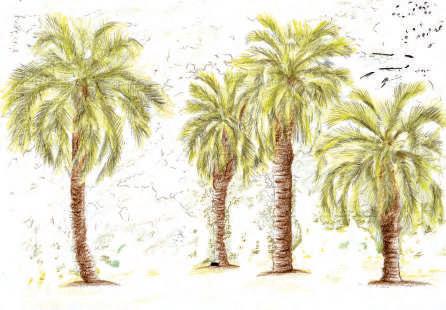
3 minute read
Precedent study and comparison with the current design of
Fig. 1 Butia Palms (native to Brazil), Melbourne Royal Botanical Gardens

Advertisement
Royal Botanical Gardens, Melbourne, Victoria
A scientific garden
1. History and significance of the Gardens 2. Understanding Von Mueller’s gardenesque design style in the Gardens 3. Precedent study and comparison with the current design of Melbourne’s Royal Botanical Gardens 4. Gardenesque in Guilfoyle’s modifications from 1909 gardenesque in the Royal Botanical Gardens today 5. Conclusion 6. References
The site of the Royal Botanical Gardens in Melbourne, Victoria, holds historical and cultural significance for the Aboriginal people of the Eastern Kulin Nation as their ancestral lands (see fig. 2). 1

Natural rock escarpment

Melbourne’s early Botanical garden design was driven by its colonial founding and development from 1835 , focusing on plant 2 conservation and scientific inquiry. 3
Fig. 2. Plaque commemorating the Aboriginal heritage of the site (see position on fig. 4 and 11)
Officially established in 1846 by Victoria’s first governor Charles La Trobe , Melbourne’s 4 Royal Botanical Gardens has since evolved from its strictly gardenesque display of exotic plants to a more picturesque (see fig. 3) recreational “inner-city oasis” of heritage and economic 5 significance to Victoria.
These are the relics of what was once the edge of the Yarra River (see map 1 and change of river course in map 2) Picturesque display of exotic plant species with low shrubs next to footpath and taller trees in the background Fig. 3. Plaque commemorating all the curators of the Gardens from its establishment to current time (see position on fig. 4 and 11)
Key figures involved in the shaping of the Botanical Gardens (also mentioned in the commemorative plaque in fig. 3) include the Gardens’ first director – the notable German-Australian botanist Baron Sir Ferdinand Von Mueller (from 1857-1873), and landscape gardener, botanist and architect William Guilfoyle (from 1873-1909).6
Von Mueller’s interest in economic advancements and scientific study of plants, followed by Guilfoyle’s interest in garden beautification embracing social values and recreational use , resulted in major differences between the Botanical Gardens’ initial gardenesque layout of 7 1873 (see fig. 4) and its current Picturesque layout from 1909 (see fig. 11).
This chapter analyses the Melbourne Royal Botanical Gardens from the lens of Von Mueller’s gardenesque design and strives to place its identity in Guilfoyle’s more picturesque setting that dominates the Garden’s design today. Aviary - current location of Fern Gully (see fig. 11)
1.2. Von Mueller’s gardenesque design
Under Von Mueller’s directorship, Melbourne’s Royal Botanic Gardens was a “scientific center” , where distinct 8 collections of plants were brought from exotic locations abroad (see fig. 1), and were carefully labelled and displayed with ample spacing to allow for each species to be studied and celebrated for its individuality and to be able to grow to its full potential (see fig. 4). 9
This allowed Von Mueller to introduce and study plant species new to Australia in nurseries and institutions
exotic planting along the margins with each tree standing alone with ample spacing, allowing them to grow to full potential Geometric plant beds with long linear pathways - enabled viewing and studying each displayed plant species
10
2 3

12
within the Gardens (see fig. 11 and 14), as well as introduce economically significant plants that were native to Australia, such as the eucalypts (see fig. 13), to other parts of the world.10
White space is open lawn areas/ spaces for nurseries etc. - no trees planted in groups - celebrating the individual tree
14




